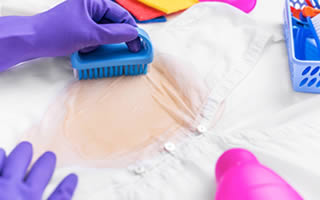Is there anything worse than having your favorite shirt stained and it did not come out in the first wash? Repeating the laundry process and dealing with a stubborn stain makes laundry more dislikable.
You can overcome this problem by using a stain remover first before washing them. There are two categories for stain removers that you can choose from, natural and commercial options. Most commercial stain removers have harsh and toxic chemicals, making them harmful to you and the environment.
We don’t want to introduce only one option for you, so we will explore the best commercial and natural stian removers you can use in this article.
Commercial Stain Remover
You can stock these helpful commercial stain removers in your laundry room. Before you use these commercial spot removers, try them on a non-visible area of the clothes.
2. Pre-Wash Spot Removers
Pre-wash spot removers are best to apply before washing the clothes. It has a cleaning agent or surfactant that loosens the stains and make the stain easily removed by water. The pre-wash spot remover is preferred on stained white shirts to improve whiteness. Moreover, it has an enzyme that works on protein stains to make it easier for the laundry detergent to remove the stain thoroughly.
If you use bleach on stains on colored clothes, make sure to use the color-safe bleach. Do not use bleach with colored clothes and white; the color will transfer to other items in the laundry and may ruin your white clothes.
3. Dry-Cleaning Fluid or Petroleum-Based Pretreatment Solvent
If you have problems with ballpen inks, crayons, or makeup stains the best pretreatment is dry-cleaning fluid. However, this option is not quite friendly to use; it can be extremely flammable. Meanwhile, the petroleum-based solvent is the best stain remover for grease and gasoline stains.
If you are using either of these commercial stain removers, it is best to check the wash label of your clothes.
Natural Counterparts
If you want to limit harsh chemical exposure, the best method is to use the natural counterparts of stain removal. Most of the natural stain removers are found in your kitchen.
4. Baking Soda
Baking soda is the best natural stain remedy. It is not even expensive to have; you can just check your kitchen cabinet and see it sitting there. Baking soda is the best stain and odor remover. You can use it on all types of fabric, even children’s wear.
What’s more impressive is it boosts the detergent performance by softening the fabric and reducing the suds.
5. Borax
You might think why borax is included in natural stain removers when it is most likely associated with chemicals in a laboratory. Well, that’s a mere misconception; borax is a natural-occurring mineral made from boron, oxygen, sodium, and water. It does not emit any toxic fumes, making it safe for the clothes and environment.
Adding borax into your detergent boosts the cleaning performance. It also softens hard water and control odor.
6. Distilled White Vinegar
If you almost feel like giving up, the distilled white vinegar brings the miracle in laundry problems. It is an expensive option that you can quickly get from your kitchen cabinet. Distilled white vinegar is a safer solution than chlorine bleach and fabric softener.
White vinegar is the best stain remover for yellow underarm stains and odors. It whitens and brightens your clothes. Do not use apple cider vinegar, and it will only result in more stains on the fabrics.
Add one cup of distilled white vinegar to the first rinse of your laundry. It makes them soft and fresh. You can even clean your washing machine and remove its musty odors with white vinegar.
7. Lemon or Lime Juice
Whether bottled or freshly pressed lemon juice has a natural bleaching action on fabrics. But, it has to be a hundred percent natural to have the acetic acid. Lemon juice is best to remove yellow underarm stains. You should only use the lemon juice on white cloth stains. It Using it on colored clothes may cause permanent discoloration.
8. Table Salt
Homemakers have an old tale with table salts as stain removers; it sets the dye and stops color bleeding. But, if you do this today, the table salt does not work that way on the fabrics and dyes.
Sprinkle salt to remove red wine and rust stains. It absorbs liquid stains before the wine sets in. After absorbing the liquid, brush off the salt or leave a white stain on the fabric.
Which do you prefer, the natural remedies or chemical-laden commercial stain removers? It is best to try which stain remover can effectively and thoroughly remove the stain without harming you and the environment.





